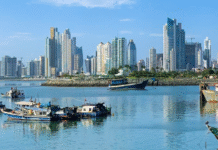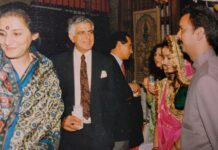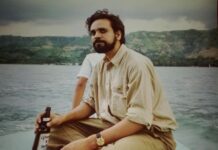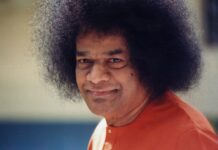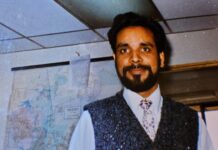By Upendra Mishra, Author of After the Fall and Precise Marketing
BOSTON — My first trip to Nicaragua in the mid-1980s was a shocker.
Even before I had a chance to adjust to the blistering tropical heat, I was struck by something else entirely: women—everywhere. In the market stalls selling mangoes and plantains, behind counters in small government buildings, driving rickety buses, walking confidently into offices and parliament buildings, even leading neighborhood patrols with rifles slung over their shoulders. Nicaragua in those years had the feel of a country that had handed the reins of daily life to its women—because it had no other choice.

I asked one of my friends, whom I had met earlier in Costa Rica, why this was so.
His response was swift: “Most men have died in the Sandinista-Contra conflict or are in the war zone.”
“Do you know what is the men-to-women ratio in Nicaragua?” he asked me.
“No,” I replied.
“It is ten women for every one male,” he said. “These days it’s so common for a man to have multiple affairs—and it’s socially accepted. There just aren’t enough men.”
What he said made sense. Nicaragua in the mid-1980s was at the epicenter of the Cold War’s tropical frontline—a land of paradoxes, ideological extremes, and unfathomable loss.
On one side stood the Sandinistas, who had overthrown the U.S.-backed Somoza dictatorship in 1979. They were socialist revolutionaries supported by the Soviet Union and Cuba, determined to restructure Nicaraguan society in the image of Marxist ideals. On the other side were the Contras, rebel groups trained, funded, and armed by the United States to overthrow the Sandinistas. Reagan called them “freedom fighters.” Others called them mercenaries and terrorists.
This was the era of the Iran-Contra affair—a scandal that would later reveal how the U.S. government, despite Congress prohibiting further military aid to the Contras, secretly sold arms to Iran and funneled the profits to support these rebel fighters. Nicaragua wasn’t just fighting a civil war—it was caught in the teeth of a global ideological battle, where ordinary people paid the price.
To explore the conflict further, I traveled toward the Nicaragua–Costa Rica border, where many Contra groups were believed to operate. Even now, after so many years, I can’t say with certainty whether I was still on the Nicaraguan side or had unknowingly crossed into Costa Rica. The border was porous, unmarked in places, and conflict routinely spilled across it. Many Contra camps and staging areas were based just over the Costa Rican side.
My luck—or perhaps recklessness—got the better of me. I was stopped and briefly captured by a group of Contra rebels.
They were young. Ragged. Most couldn’t read. Their hands were calloused not from farming, but from holding rifles. Their eyes had that peculiar mix of boyish curiosity and hardened suspicion.
They could immediately tell from my accent that I wasn’t local.
“Where are you from?” one of them asked.
“India,” I replied.
“Where is India?” he asked, squinting.
“It is far away from here,” I said.
“Is it farther than the United States?” another chimed in.
“Yes,” I said. “Much farther.”
The United States was the center of the universe for them. It was all they knew, all they talked about. Their godfather, their sponsor, their invisible hand. But still, they were genuinely curious about where I came from. So, I picked up a stick, cleared a patch of dirt, and began drawing a rough map of the world: Americas on the left, Europe and Africa in the middle, and Asia on the right. I pointed out where India was.
For the next four or five hours, I ended up giving them an impromptu geography lesson, right there in the jungle, surrounded by AK-47s, mango trees, and the rustle of war.
But no matter where our conversation wandered, it always came back to America.
“Have you been there?”
“What are Americans like?”
“How rich is it, really?”
I remember thinking, what a paradox. These young men had guns in their hands and the innocence of children in their eyes. They could kill without blinking—but they asked questions with the sincerity of schoolchildren. It was a strange, tragic beauty: how government propaganda, hunger, or the promise of a few dollars a month could turn a child into a soldier—but still couldn’t erase the light in their hearts.
Eventually, they let me go.
Back in Managua, I was still a student, staying with friends I had met earlier in my travels. They showed me around—restaurants, nightclubs, parks, and lakes. One afternoon they took me to a serene lake just outside the city. What surprised me was who surrounded it: Soviet advisors, living in beautiful cottages, drinking, relaxing, and enjoying what looked like a vacation in a war-torn country. The contrast was jarring. While Nicaraguans died fighting a proxy war, the Soviets lounged lakeside, protected by armed guards and enjoying the good life.
Later that evening, we returned to Managua and went out to a lively restaurant-nightclub. Again, women dominated the space—not just as servers or entertainers, but as patrons, dancers, and drivers of the night. The entire social rhythm had shifted, out of necessity. And the gender imbalance was unmistakable.
As dinner ended and we prepared to leave, two women—both strong, confident, and clearly used to getting what they wanted—got into a literal fistfight over who would drive me home. I didn’t know whether to be flattered or alarmed. But that moment, in all its absurdity, captured the spirit of Nicaragua in the 1980s: raw, unpredictable, and full of contradictions.
Earlier that day, I had gone out on my own and asked someone for directions. That, too, took me by surprise—and brought a warm wave of nostalgia. Managua, like much of Nicaragua, had no formal street addresses. Homes weren’t numbered. Directions came in a familiar, almost poetic style: “Go left until you see a tall mango tree, then turn right where the dog sleeps, and when you get to the yellow wall with the rooster painted on it, ask someone there.”
It was just like India. That beautiful chaos of direction-giving—no maps, no signs, just people and landmarks. It made me smile. So far from home, and yet, in that moment, I felt oddly close to it.
The smell of fried plantains and gasoline hung in the air. Salsa music drifted from homes and radios, mingling with the distant thud of artillery from the countryside. Despite everything—despite the war, the politics, the poverty—life moved forward. People laughed, danced, flirted, and fought. And most of all, women—left behind by war—held up what was left of the country with fierce, unrelenting grace.
Stay tuned for Memoir-31: The First Massage in Honduras.
(Upendra Mishra is the author of After the Fall: How Owen Lost Everything and Found What Really Matters and Precise Marketing: The Proven System for Growing Revenue in a Noisy World. He is the Managing Partner of The Mishra Group. Learn more at www.UpendraMishra.com.)




